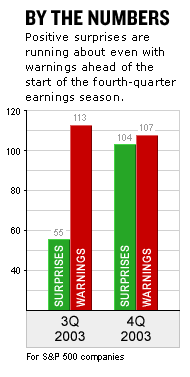NEW YORK (CNN/Money) -
Investors on Wall Street expect nothing but good things from companies in the fourth quarter, but even they may be surprised by how strong results will be.
Hang it on an economy that is running at an incredible clip. Although nobody expects growth to reach anywhere near the third quarter's 8.2 percent pace, economists have been upping estimates for both the current quarter and next year.
|
 |  | Quarter |  | Estimate at start of quarter |  | Actual growth* |  | 1st quarter 2002 | -12.6% | -11.5% |  | 2nd quarter 2002 | 2.4% | 1.4% |  | 3rd quarter 2002 | 16.6% | 6.8% |  | 4th quarter 2002 | 19.9% | 9.7% |  | 1st quarter 2003 | 11.7% | 11.7% |  | 2nd quarter 2003 | 7% | 9.5% |  | 3rd quarter 2003 | 12.7% | 21.5% |  | 4th quarter 2003 | 22.3% | ? |
|  |  |
| * 3rd-quarter 2003 not final | | Source: First Call |
|
Meantime, many of the cost-cutting measures that companies put through during the downturn remain in place. Those allowed earnings to rise in the first half of this year even as sales remained flat. Sales are now accelerating, and much of these higher revenues will fall directly to earnings.
"Top-line demand, productivity growth and cost cutting -- that's a trifecta for profit growth," said Bank One chief economist Diane Swonk. "Sprinkle on low interest rates and you can't help but have a slam dunk."
Swonk reckons that earnings for companies in the S&P 500 could show year-on-year growth of close to 30 percent (maybe even more) in the fourth quarter -- making it the best period for profits growth in over a decade.
Wall Street analysts are not quite as bullish, expecting earnings growth of 22 percent, according to First Call. But they have also been raising estimates at a furious pace. At Merrill Lynch, for instance, the ratio of upward earnings revisions to downward revisions has only been as high as it is now a handful of times in the past two decades, according to the firm's strategy group.
News from companies has also been extremely good. Jeff Matthews, who heads up the hedge fund Ram Partners, said he was struck listening in on a lousy conference call from publisher John Wiley & Sons (JW.A: Research, Estimates) Tuesday by just how long it had been since he'd heard a company say anything negative. It's a sharp contrast from this time last year, when it was hard to remember the last time a company had said anything positive.

The news in technology, said Matthews, has been particularly swell. Executives at conferences appear to have gotten the old spring back in their steps and recent good news from computer and software distributors Tech Data (TECD: Research, Estimates) and Ingram Micro (IM: Research, Estimates) suggest strong demand for tech products.
"If there's a sign you want to see in tech, it's those guys saying things are OK," said Matthews.
Investors will get a better inkling of exactly how good things are for tech when Intel (INTC: Research, Estimates) gives its mid-quarter update after the market closes on Thursday.
Another indication of how strong results could be for the fourth quarter is how few companies have guided estimates lower.
Typically, a company that isn't going to make its numbers tries to get the bad news out of the way early in the quarter, on the view that investors will take this more easily than they would a negative surprise during earnings season. Companies with good news, on the other hand, hold back on the view that investors love positive surprises.
As a result, in past years at this point in the fourth quarter, more than twice as many companies in the S&P 500 have warned than said results would be better than expected, according to First Call strategist Joe Cooper. But this time around the number of warnings is running neck and neck with upside surprises, suggesting that results will be far better than analysts are forecasting.
 |
YOUR E-MAIL ALERTS
|
Follow the news that matters to you. Create your own alert to be notified on topics you're interested in.
Or, visit Popular Alerts for suggestions.
|
|
|
Arguably, investors should be mindful that this quarter will likely indicate the high point for profits growth for years to come. As companies hire back workers (a prerequisite for continued economic growth), costs will rise, narrowing margins in the year to come. And year-on-year comparisons are going to get a lot tougher.
But such cautionary points could easily fall by the wayside in the midst of one of the biggest profit surges Wall Street has seen in recent history.

|

